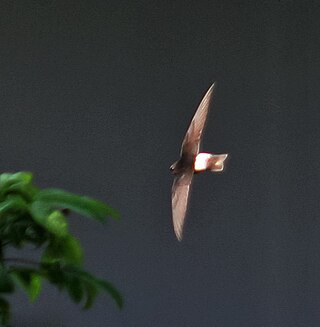
The western mosquitofish is a North American freshwater fish, also known commonly, if ambiguously, as simply mosquitofish or by its generic name, Gambusia, or by the common name gambezi. Its sister species, the eastern mosquitofish is also referred to by these names.

The little swift, is a small species of swift found in Africa and southwestern Asia, and are vagrants and local breeders in southern Europe. They are found both in urban areas and at rocky cliffs where they build nests in a way typical of all members of the order Apodiformes. The genus name Apus is Latin for a swift, thought by the ancients to be a type of swallow without feet. The Latin specific affinis means similar to or related to, but in this case the species that the little swift supposedly resembles is not clear from the description. A population formerly considered to be an eastern subspecies of little swift is now separated as a distinct species, the house swift.

Blyth's frogmouth is a species of bird in the family Podargidae. It lives in the tropical and subtropical moist broadleaf forests of Brunei, Cambodia, Indonesia, Laos, Malaysia, Myanmar, Thailand, and Vietnam, and feeds on invertebrates. It is sometimes considered conspecific with the Javan and Palawan frogmouths.

The black-chested jay is a species of bird in the family Corvidae.

The intermediate horseshoe bat is a bat species of the family Rhinolophidae that is very widespread throughout much of the Indian subcontinent, southern and central China and Southeast Asia. It is listed by IUCN as Least Concern as it is considered common where it occurs, without any known major threats.
Dystasia is a genus of longhorn beetles of the subfamily Lamiinae, containing the following species:
Dystasia javanica is a species of beetle in the family Cerambycidae. It was described by Stephan von Breuning in 1938.
Dystasia proxima is a species of beetle in the family Cerambycidae. It was described by Stephan von Breuning in 1938. It is known from Borneo.
Dystasia siamensis is a species of beetle in the family Cerambycidae. It was described by Stephan von Breuning in 1938.
Dystasia subcristata is a species of beetle in the family Cerambycidae. It was described by Stephan von Breuning in 1938.
Dystasia bella is a species of beetle in the family Cerambycidae. It was described by Stephan von Breuning in 1940.
Dystasia chassoti is a species of beetle in the family Cerambycidae. It was described by Stephan von Breuning in 1973.
Dystasia laterivitta is a species of beetle in the family Cerambycidae. It was described by Stephan von Breuning in 1942.
Dystasia valida is a species of beetle in the family Cerambycidae. It was described by Stephan von Breuning in 1937. It is known from Borneo.
Dystasia semicana is a species of beetle in the family Cerambycidae. It was described by Francis Polkinghorne Pascoe in 1864.
Dystasia cristata is a species of beetle in the family Cerambycidae. It was described by Warren Samuel Fisher in 1933.
Dystasia sibuyana is a species of beetle in the family Cerambycidae. It was described by Per Olof Christopher Aurivillius in 1927. It is known from Malaysia, the Philippines and Borneo.
Dystasia similis is a species of beetle in the family Cerambycidae. It was described by Charles Joseph Gahan in 1907.
Dystasia tonkinea is a species of beetle in the family Cerambycidae. It was described by Maurice Pic in 1930.
Dystasia variegata is a species of beetle in the family Cerambycidae. It was described by Warren Samuel Fisher in 1936.




